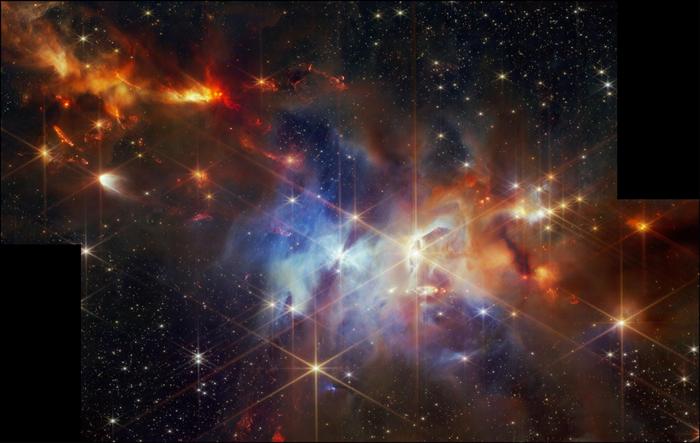NASA’s James Webb Space Telescope has made a remarkable discovery in the Serpens Nebula, capturing an unprecedented image of aligned protostellar outflows. This finding, located in the northern area of the nebula, offers new insights into star formation processes and challenges previous assumptions about stellar birth.
Aligned Jets: A Cosmic Symphony of Star Birth
The image reveals a group of protostellar outflows, all slanted in the same direction and to the same degree. These outflows are formed when jets of gas from newborn stars collide with surrounding gas and dust at high speeds. Typically, such objects have varied orientations within a region, making this aligned configuration particularly intriguing.
“Astronomers have long assumed that as clouds collapse to form stars, the stars will tend to spin in the same direction,” said principal investigator Klaus Pontoppidan of NASA’s Jet Propulsion Laboratory. “However, this has not been seen so directly before. These aligned, elongated structures are a historical record of the fundamental way that stars are born.”
Webb’s Unique View of the Serpens Nursery
The Serpens Nebula, located 1,300 light-years from Earth, is a cosmic nursery only one or two million years old. Webb’s advanced capabilities have allowed astronomers to observe this region with unprecedented clarity, revealing features previously invisible or indistinct.
“This area of the Serpens Nebula – Serpens North – only comes into clear view with Webb,” said lead author Joel Green of the Space Telescope Science Institute. “We’re now able to catch these extremely young stars and their outflows, some of which previously appeared as just blobs or were completely invisible in optical wavelengths because of the thick dust surrounding them.”
The image also showcases a dense cluster of newly forming stars at the center, with some potentially growing to the mass of our Sun. Throughout the region, filaments and wisps of different hues represent reflected starlight from still-forming protostars within the cloud.
This groundbreaking observation is just the beginning. The research team plans to use Webb’s Near-Infrared Spectrograph (NIRSpec) to investigate the chemical composition of the cloud, focusing on volatile compounds crucial for star and planet formation.
“At the most basic form, we are all made of matter that came from these volatiles,” Pontoppidan explained, highlighting the significance of this research for understanding our own solar system’s origins.
As Webb continues to unveil the mysteries of the cosmos, this image of the Serpens Nebula stands as a testament to the telescope’s power to revolutionize our understanding of star formation and the early universe.
Here are three additional resources you can explore to learn more about the James Webb Space Telescope and its discoveries:
-
NASA’s James Webb Space Telescope Successfully Completes First Orbit (https://webb.nasa.gov/) by NASA: This press release from NASA details the successful launch and first orbit of the James Webb Space Telescope. It also provides an overview of the telescope’s capabilities and scientific goals.
-
Webb Telescope’s Dazzling Nebula Image Supports a Long-Held Theory (https://scienceworld.scholastic.com/issues/2023-24/121823/dazzling-nebula.html) on Engadget: This news article discusses the image of the Serpens Nebula captured by Webb, highlighting the discovery of aligned protostellar outflows and its implications for our understanding of star formation.
-
What is the James Webb Space Telescope? (https://science.nasa.gov/mission/webb/) on NASA (.gov): This NASA webpage provides a comprehensive overview of the James Webb Space Telescope, including its design, instruments, and scientific mission.
If our reporting has informed or inspired you, please consider making a donation. Every contribution, no matter the size, empowers us to continue delivering accurate, engaging, and trustworthy science and medical news. Independent journalism requires time, effort, and resources—your support ensures we can keep uncovering the stories that matter most to you.
Join us in making knowledge accessible and impactful. Thank you for standing with us!

